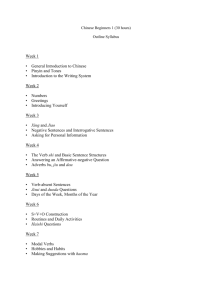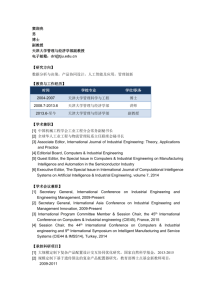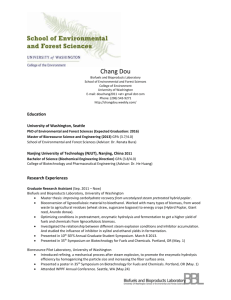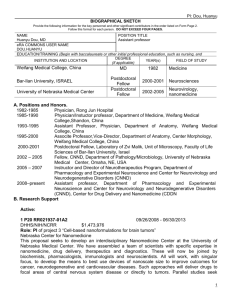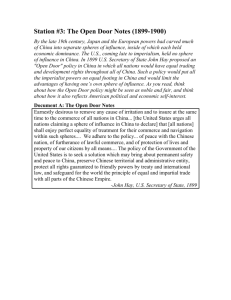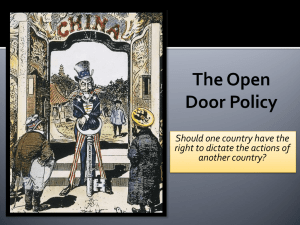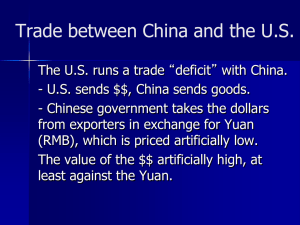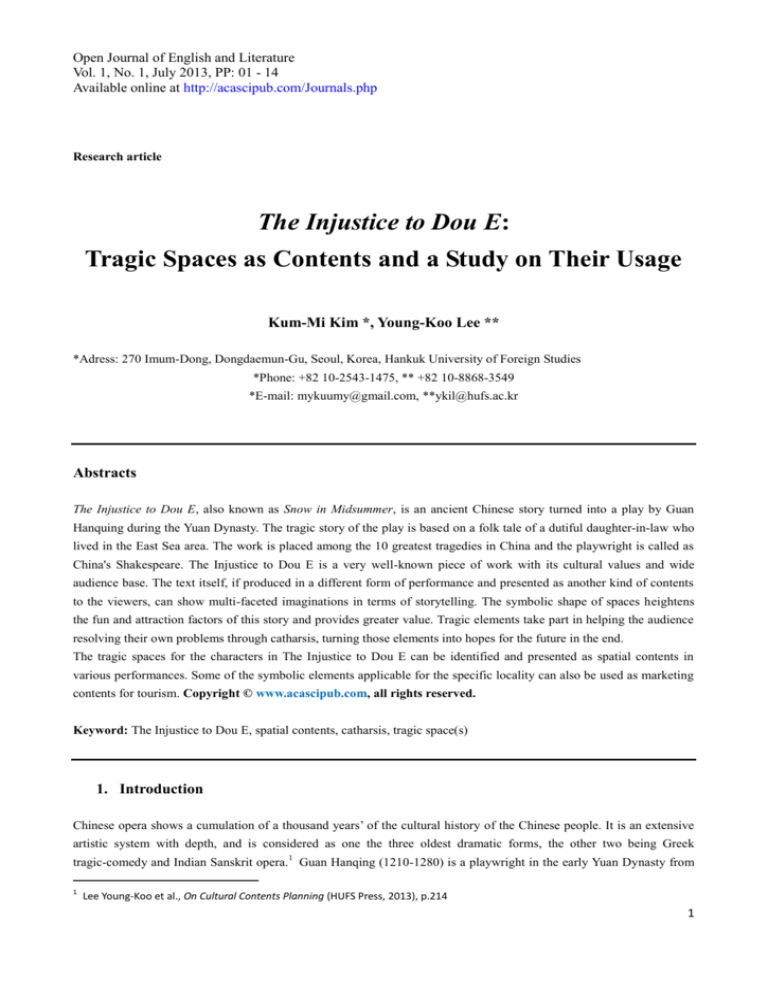
Open Journal of English and Literature
Vol. 1, No. 1, July 2013, PP: 01 - 14
Available online at http://acascipub.com/Journals.php
Research article
The Injustice to Dou E:
Tragic Spaces as Contents and a Study on Their Usage
Kum-Mi Kim *, Young-Koo Lee **
*Adress: 270 Imum-Dong, Dongdaemun-Gu, Seoul, Korea, Hankuk University of Foreign Studies
*Phone: +82 10-2543-1475, ** +82 10-8868-3549
*E-mail: mykuumy@gmail.com, **ykil@hufs.ac.kr
Abstracts
The Injustice to Dou E, also known as Snow in Midsummer, is an ancient Chinese story turned into a play by Guan
Hanquing during the Yuan Dynasty. The tragic story of the play is based on a folk tale of a dutiful daughter-in-law who
lived in the East Sea area. The work is placed among the 10 greatest tragedies in China and the playwright is called as
China's Shakespeare. The Injustice to Dou E is a very well-known piece of work with its cultural values and wide
audience base. The text itself, if produced in a different form of performance and presented as another kind of contents
to the viewers, can show multi-faceted imaginations in terms of storytelling. The symbolic shape of spaces heightens
the fun and attraction factors of this story and provides greater value. Tragic elements take part in helping the audience
resolving their own problems through catharsis, turning those elements into hopes for the future in the end.
The tragic spaces for the characters in The Injustice to Dou E can be identified and presented as spatial contents in
various performances. Some of the symbolic elements applicable for the specific locality can also be used as marketing
contents for tourism. Copyright © www.acascipub.com, all rights reserved.
Keyword: The Injustice to Dou E, spatial contents, catharsis, tragic space(s)
1. Introduction
Chinese opera shows a cumulation of a thousand years‘ of the cultural history of the Chinese people. It is an extensive
artistic system with depth, and is considered as one the three oldest dramatic forms, the other two being Greek
tragic-comedy and Indian Sanskrit opera.1 Guan Hanqing (1210-1280) is a playwright in the early Yuan Dynasty from
1
Lee Young-Koo et al., On Cultural Contents Planning (HUFS Press, 2013), p.214
1
Open Journal of English and Literature
Vol. 1, No. 1, July 2013, PP: 01 - 14
Available online at http://acascipub.com/Journals.php
Daidu, now a part of Beijing, who used a sobriquet of Zhāisǒu or ―the old man in the studio.‖ After the South Sung
collapsed, Guan travelled around Hangzhou and Yangzhou, where most of the southern Zaju plays and performances
were created. He himself was good at singing and dancing and well-versed in tunes; he wrote many Zaju plays and
participated in many performances as an actor. The Injustice to Dou E or Snow in Midsummer took the basic material
from an old folktale about a filial daughter-in-law in the Eastern coast. This is the original story: A widowed young
woman faithfully takes care of her mother-in-law but the old lady kills herself hoping that the young woman to live a
better life; but the daughter-in-law is placed under a suspicion of poisoning and becomes executed; the injustice leads to
a deep sorrow and resentment of the ghost, which brought a severe drought for three years to the village; a Master Wu
clears her name, performs ceremonies for the dead and the curse is gone.2
According to ―Snow in Midsummer: Literary Classics and Stage Classic Fortuity,‖3 The story is a classic highly
recognized both from literary and stage perspectives. It has been constantly adapted on stage, from the Ming and the
Qing Dynasties as well as in the New China after 1949. Since 1958, the story has been adapted into 88 versions for
performance. The most frequent formats include Peking (Beijing) opera, Hebei and Shaanxi opera.
Lee Young-Koo says in On Cultural Contents Planning, a play continues to be produced and performed not only
―because of financial gains but also because of the spiritual pursuit of culture, which is very important.‖ He adds,
―Planning is not just about proposing ideas – it is about devising a program, making a projection and achieving a goal.
Therefore, it is important to induce creativity, productivity, motivation and attention in planning.‖ 4 We as researchers
need to have an attitude to generate attention to classic literature and to combine the old with the new.
1) Preceding Studies
Wanfang Data(http://www.wanfangdata.com.cn/: 万方数据知识服务平台) is an online search engine for Chinese
academic papers. A keyword search using 窦娥冤 (Dou E Yuan) retrieves papers in five main categories: spirit of
tragedy; translation; classic culture; justice system; and education. The following show some major papers retrieved.
Thesis for M.A. program within China include: Difference between Eastern and Western Sprit of Tragedy – A
Comparative Analysis of the Injustice to Dou E and Hamlet (Yuan Heng, LiaoNing Normal University 2007), A
Comparative Study on Antigone and the Injustice to Dou E (Wu Zeqiong, HaiNan University 2009), An In-depth Study
of Factors that Induced Dou E’s Tragedy (Xu Fangfang, Henan University 2011), A Study on the Model and Ideology of
Justice in the Injustice to Dou E (Chen Zongfeng, SuZhou University 2009), A Comparative Study on Translation
Tactics for Classics – Focusing on English Translation of the Injustice to Dou E(Chen Nan, Dalian Maritime University
2011),
A Comparative Study on the Supernatural Elements in Shakespearean Plays and Classic Chinese Plays(Zeng
Bing, AnHui University 2011) and A Study on the Method of Education for the Yuan Zaju Plays in Middle School
Chinese Class – Focusing the Injustice to Dou E (Xu Jihong, HuaZhong Normal University 2001).
Thesis for Ph.D. program include: An Argument for and Discovery of Spirit of Tragedy in Yuan Plays (Zhang Wenshu,
Beijing Normal University 2005)and Court Trial Drama among Zaju Plays. These two are the most recent theses and
we can feel the lack of Ph.D papers.
As for academic journals, there are following articles: An Analysis of Values in Dou E’s Tragedy(Chen Yanni, Jianghan
2
Guan Hanqing, The Injustice to Dou E & The Wife-Snatcher, trans. Hah Kyung-shim (Jimanji, 2008), p.14-15
3
李晓彬,「
《窦娥冤》
:文学经典与舞台经典的遇合」,『长江学术』, 2012 年 1 期
4
Lee Young-Koo et al., Ibid. p.6
2
Open Journal of English and Literature
Vol. 1, No. 1, July 2013, PP: 01 - 14
Available online at http://acascipub.com/Journals.php
Tribune 2012 No. 12),
A Sorrowful Life: World of Metaphors in the Injustice to Dou E (Li Hongxia, Sichuan Drama,
2012 No. 2), Confucius Emotions that Cannot Be Disentangled – Cultural Nature of Chinese Tragedy Represented by
the Injustice to Dou E(Xu Wei, Literature Life (Next Trimonthly Publication 2012 No. 7),
Dramatic Characteristics of
Guan Hanqing Injustice to Dou E(Feng Lihong, Jian Nan Wen Xue (CLASSICS), 2012 No. 11); Confucianism in Guan
Hanqing – Focusing on the Injustice to Dou E(Zhang Meng & Wang Rui, Northern Literature, 2012 No. 5),
A Study
on Popular Customs from a Yuan Zaju Play of the Injustice to Dou E (Han Pengpeng, Northern Literature, 2012 No. 1),
The Injustice to Dou E – An Encounter and Combination of a Literary and a Stage Classic (Li Xiaobin, Yangtze River
Academic, 2012 No. 1) and An Interpretation of Aesthetic Culture in Description of ‘Ghost’ in the Injustice to Dou E
(Zhang Jie,
New West(Late Theoretical Version), 2012 No. 6).
Academic discussions consider this piece of literature as something spatial on stage, but there is no study on spatial
contents; the majority focuses on the understanding of the work from mental and spiritual perspectives as seen above –
as a tragedy or for Confucianism and aesthetic interpretation.
Let alone spatial contents, contents development has hardly been studied. The Injustice to Dou E: An Encounter and
Combination of a Literary and a Stage Classic implies that we need research and development of spatial contents.
Some titles from Korean studies include: On the Injustice to Dou E; A Departure from the Human’s Desire Expressed in
Folk Literature: Focus on Human and Ghost Affection Ancient History; and A Study on Female Forms in Yuan Plays.5
One paper that has a theme linked to space may be Mythical Archetype Space in the Injustice to Dou E. Further studies
both in and outside Korea are necessary regarding the play or the folktale, which should be lead to cooperation between
Korea and China to exchange contents from planning and development perspectives. It is also necessary to pay close
attention to the storytelling and spatial contents of classic literature.
2) Concept of Tale(故事) and Understanding of Space
According to Dictionary of Theories of Literature, a ―tale‖ is a series of incidents of life that have causal relations. Such
incidents always have conflicts with twists and turns and a narrative arc. A tale or a story is a genre of literature the
describe the progress of events, with emphasis on narrative arc and expression of values. 6
Cihai says that a ―tale‖ is a series of incidents of life which appear in narrative literature to express the character and
theme; there are close relations and development, which constitute a powerful story or an interesting plot.7
Meanwhile, Baidu, an online collaboratively built Chinese encyclopedia and a keyword-based search engine, carries
only handful meanings for the word with very few examples. The dictionary definition for Tale(故事) includes a
5
In the Yuan drama, diverse types of women exist by class. Their elements can be described in many words incluidng positive,
negative, static, dynamic, passive, victimized, aggressive and progressive; their forms can be described as defensive, conservative or
traditional . From the royal to the commoner, complex conflicts prevail and characters of all sexes, ages and ranks are depicted.
6
““故事”,指文学作品中一系列有因果联系的生活事件。这种生活事件,往往有曲折生动的冲突,环环相扣,有头有尾的发
展过程.” 郑乃臧·唐再兴 主编,『文学理论词典』, 光明日报出版社,(1987), P23. “Tale (故事).” Baidu(百度百科). Baidu Inc.
Retrieved as at 10 May, 2013. Web. <http://baike.baidu.com/view/23054.htm>
7
““故事是叙事性文学作品中一系列为表现人物性格和展示主题服务的因果联系的生活事件,由于它循环发展,环环相扣,
成为有吸引力的情节,故又称故事情节.” 辞海编辑委员会,『辞海』, 上海辞书出版社,(1989), p. 3846.
3
Open Journal of English and Literature
Vol. 1, No. 1, July 2013, PP: 01 - 14
Available online at http://acascipub.com/Journals.php
precedent, a history or an old story in Chinese and a story from the old times in Korean. In this sense, the original Dou
E Yuan indicates an old story about a woman‘s grudges. In order to better understand the tale, we need to understand the
background and the characteristics of where she lived.
Park Wan-ho says, in terms of beliefs by class, the ―tales were expressed in a literary manner more often among the
commoners than among the domicile upper class during the Wei, Jin and Southern and Northern Dynasties.‖ Such tales
were the ―representation of ghost stories through certain physical enactment rituals.‖ Park adds, ―The ancient Chinese
perceived the human and the ghost or the performer and the receiver of those rituals to be on different dimensions, still
believing in the existence of ghosts.‖ 8 There is another perspective: ―There were more writings similar to a fantasy or a
romance in a form of fable or folktale, rather than in a form of traditional literature. They reflected realistic human
beings, at the same time projecting human hopes, dreams and desires. The ancient Chinese considered the existence of
ghosts to be the most convincing expression of human existence itself.‖ 9
Wasabi Akiba says, in spatial interpretation of an image map, that he considers it ―not as some combined places that
surround human abode, but as a vast space that goes beyond it – as a phenomenon. Local spatial features experienced
by people change even within the same waters or the same region, depending on what route was chosen, at what season
or what time.‖10
The tale of Dou E can be understood or interpreted differently according to diverse places and cultural backgrounds of
the reader. Yet the story uses a feasible and universal narrative and presents us with the same space where both human
beings and ghosts coexist. Surreal phenomena are reenacted here, reflecting dreams and hopes of human beings.
2. Catharsis through Tragic Elements
The Injustice to Dou E has a different story from the original tale. Dou E‘s mother died when she was very young. The
father, Dou Tianzhang, sent her as a child bride to the Cai family in usury business, because he could not repay debts.
Shortly after the marriage, Dou E‘s husband dies but she continues to live with her mother-in-law. Then a villain of
Zhang Luer appears coaxing both women for a marriage but Dou E firmly declines. Zhang plots to poison the
mother-in-law to get Dou E but he ends up killing his own father by mistake. Dou E is falsely charged with murder. A
corrupt magistrate holds a very unfair trial against her and she is decapitated. Later, Dou Tianzhang becomes a
high-ranking government official and comes to this village. Dou E appears in his dream, asking him to clear her name.
The father discovers that the three vows made by his daughter at execution have materialized during the past three
years: not a single drop of blood spilled on the ground, all being splashed to a white silk flag; snow fell in June, after the
execution; drought continued for three years in the village. He reinvestigates the case and proves the daughter‘s
innocence. The focus is on Dou E all along, and the supernatural phenomena are ―repeatedly described to emphasize
tragic circumstances,‖ eventually appeasing her grudges.11
The story reflects the Yuan Dynasty‘ social structure under the Mongolian domination: during this dark period of feudal
8
Park Wan-ho, “A Departure from the Human’s Desire Expressed in Folk Literature: Focus on Human and Ghost Affection Ancient
History,” The Journal of Research of Chinese Novels, The Society for Research of Chinese Novels (March 2007 No. 25), p. 80
9
≪禮記正義≫47, ≪十三經注疏≫, p.1325. “衆生必死, 死必歸土, 此之爲鬼.”
10
Wakabayashi Mikio, The Imagination of a Map, trans. Jeong Seon-tae (Sancherum, 2006) pp. 92-94.
11
Ha Dong-wan, “Mythical Archetype Space in The Injustice to Dou E,” The Society for Chinese Drama in Korea, Chinese Drama No.
3 (Dec. 1995), pp.33- 62.
4
Open Journal of English and Literature
Vol. 1, No. 1, July 2013, PP: 01 - 14
Available online at http://acascipub.com/Journals.php
rule by cruelty and corruption, women, especially the poor, often became the worst victims of the system. This tale
shows women‘s agonies and social conditions of the times, as ―the Yuan writers could be closer to the audience simply
based on their social status.‖ The story ―reenacted the lives of those suffering under the problematic sexual discourse of
the times, through the intimate observation and embodiment process by the author; it also reveals the possibility of the
liberation of women who were oppressed by the authority and ideology.‖12
The tale of Dou E can help us better understand classic literature. This story also contains some cultural elements of
the symbolic Chinese ―door.‖ If we understand them properly, we can find ways to use a work of classic literature to
develop diverse spatial contents.
1) Ritual Element
Confucius said, ―Who can go out but by the door?‖ (孔子曰 ―谁能出不由户?)13 A door is a kind of security that
prevents break-ins. According to a traditional Chinese idea, a door is also a symbol of rank and social status for the
house owner. The shape, color, number and size of a door all reflect China‘s ceremonial system, while demonstrating
the power of the house. A door can be also a ritual in itself, serving to exorcise demons or pray for good luck. There is a
‗door god,‘ who retains life even in the modern times.
The Yuan Dynasty‘s nation-state experienced ideological changes under the Mongolian rule. Guan Hanqing presents us
the character of Dou E to represent the situation and develops the story to a tragic end with her death. The vows of Dou
E in Guan‘s work can be considered as a ritualistic element: a rite and a prayer within the play. A person who goes in
through a door can be affected and protected by the door‘s deity, depending on the kind, color and shape of the door; by
the act of passing through the ‗door‘, the person expresses wishful prayers.
On stage, the ‗door‘ is connected to entrance and exit and appears in a complex manner for stage direction. In
understanding the ritual element of the door culture, it is important to understand the spatial significance of door in the
text of the play.
2) Spatial Element
(1) Space of Deficiency
Ha Dong-wan interprets the play‘s space in the past to be one ―deficient of family.‖ He considers ―the father and the
daughter as blood relations, the old woman Cai and Dou E as the creditor and debtor, respectively representing a
microcosm of paternal authority and a male-dominated society.‖ 14 Here, social conditions have an impact on
relationship within a family and created an artificial relationship. This microcosm is the author‘s view of reality.
In this Yuan play, peace of a family vanishes as the housewife is ousted by the ruling Mongolian people. The tale
exposes male absence. The absence demonstrates that women play a leading role to sustain the family. Dou E‘s father is
12
Jeong Won-ji, “On the Injustice to Dou E,” Journal of Chinese Humanities, No. 2 (Dec. 1983), Society for Chinese Humanities in
th
Korea, pp. 289-290; Lee Young-koo, “Sex and Gender in the 20 Century Chinese Feminism Literature,” The Comparative Study of
World Literature (a compilation of papers for the conference), The Society for the Study of World Literature (April 2002), pp.
85-99.
13
杨们峻,『论语详注』, 中华书局出版社, 2005, p.61.
14
Ha Dong-wan, Ibid. pp.33- 62.
5
Open Journal of English and Literature
Vol. 1, No. 1, July 2013, PP: 01 - 14
Available online at http://acascipub.com/Journals.php
described as ruthless when he sells his young daughter for debts – a social condition in which men deviates from the
mainstream or cannot participate in the system; however, he later becomes a proxy for Dou E to resolve her grudges and
give peace.
(2) Space of Conflict
Spatial elements generally can be divided into fields of action, public places and natural environment. The first include
an apartment or a house with a living room, where family conflicts occur; The second is a new, modern type of indoor
space such as prison, police station, hospital or stadium, controlled by strict disciplines based on the national authority.15
Private spaces such as motels or entertainment quarters are public places that lack the functions of a home. The streets
are places that cannot be controlled – they offer new encounters and connections, at the same time having possible
conflicts; The third is the natural environment, a free space where people may feel nostalgia.
The mother-in-law met Zhang Luer and his father outside and by bringing them into the house, it becomes a space of
conflict. Zhang Luer‘s conspiracy brings Dou E to the government office, which is also a place of conflict for a woman.
(3) Space of Grudges
Dou E is in the 3-year mourning period for her dead husband. Zhang Luer and his father are after the mother-in-law‘s
money, coaxing Dou E to get married. They act as if it is a matter of course but the plan is thwarted by Dou E‘s firm
objection. The two men try to poison her mother-in-law but unexpectedly, the old man Zhang drinks the poison and dies.
Zhang Luer then frames Dou E for the murder. Not wanting to implicate her mother-in-law, Dou E dies under the false
charge, leaving three vows claiming her innocence: first, her blood will not fall to the ground but stick to a white silk
flag; second, snow will fall in June, after her execution; and third, drought will continue for three years in the village.
Dou E is a character that goes beyond the traditional idea of a woman; she does not bend her opinions and protects her
integrity by death. Hah Kyung-shim says, ―She is not a woman who endures suffering; she complains about her
situation, reproaches heaven and earth for it and pours out sarcastic remarks. She is the incarnation of course, a lost soul
wandering this earth.‖16
(4) Space of Self-fulfilling Prophecy
Dou E claims her innocence with three supernatural phenomena that cannot be worked by a human being and dies with
strong confidence. Her vows are ―self-fulfilling prophecies‖17 and she chooses her father as the proxy to make
something out of the supernatural phenomena. The ritual elements of ‗grudges‘ are reenacted by repeated tragic
happenings. Dou E‘s grudges are thus connected to male legitimacy or bloodline and put up a male proxy to resolve the
tragedies.
(5) Ritual Space
15
Hong Jae-woong, “Trend of Northern European Drama since Ibsen and Strindberg,” The Korean Theatre Review, Vol. 347, The
National Theatre (2005), p. 53.
16
Hah Kyung-shim, “Study on Female Forms in Yuan Plays,” The Society for the Research of Chinese Language and Literature, of
The Journal of Chinese Language and Literature No. 33 (Aug. 2005), pp.403- 432.
17
Walter Brueggeman, The Prophetic Imagination, trans. Kim Ki-cheol (Blessed People, 2009)
6
Open Journal of English and Literature
Vol. 1, No. 1, July 2013, PP: 01 - 14
Available online at http://acascipub.com/Journals.php
During the Yuan Dynasty, ―a woman‘s position was represented as a microcosm of a male-dominated society‖18; in this
society where the social participation of men and women were undergoing a transformation and women were described
as the socially discriminated. ―Bodily reenactment can be caused by abnormal deaths. It happens when; a person cannot
accept the death of a loved one; a loved one is in trouble; or a person dies of unnatural causes including a disease, an
accident or a war and has some deep grudges. Such ghosts appear in front of someone who can be their agent. ‖19
Supernatural happenings are used to ―emphasize tragic spatial elements carried by the character, repeating the rhetoric
of such tragic spaces.‖ The repeated use of tragic elements reminds the audience of the absurdity of our society. In the
end, the proxy generally satisfies women‘s grudges.
Dou E wants to prove her innocence and appears in front of her father, asking him to be a proxy to resolve the situation
based on her three vows. This unfortunate situation of a woman as a socially discriminated being is put on a real-world
stage, giving a ritual form to it with an agent acting for resolution.
(6) Space of Death
This is regarding the opening act of The Injustice to Dou E. The space is depicted as foretelling future conflicts by
something new. It is a space that transforms itself according to different characters and places.
3. Element of ‘Door’ in Tragic Space
What was the space like in the Yuan society, when Guan Hanqing wrote the play? In order to understand the play‘s
theatrical spaces, we first need to understand the physical spaces where the people lived, together with their culture.
A ‗door‘ is an essential part of Chinese architecture: it is an entrance and an exit to a residence and a point of change
connecting the inside and the outside. A door can be used to: drive out demons; pray for good luck; or symbolize the
rank and social status of the house owner. This is an element closely related to traditional Chinese ideas: the culture of a
significant door created the concept of family (comprised of Chinese characters meaning house and door, 家門).20
We can identify some symbolic doors in The Injustice to Dou E and find out what has potentials to be developed as
spatial contents.
First, Cai enters through the main entrance to visit Sai Lu Yi, a drug peddler who owes her money. Later, Sai and the
Zhangs are waiting in front of the house. The verses ‗Hunjianglong‘ sung by Dou E also have a reference to door: unlike
the splendidly adorned door in her dream, she is all agitated and teary.
Hunjianglong(混江龍)
In broad daylight or at dusk, I can neither sleep nor eat
When will this woe end?
My dream last night showed what is on my mind today
The door with shiny silk and embroidery of sprays brought tears to my eyes
18
Lee Young-koo, Ibid. pp. 85-99
19
Park Wan-ho, Ibid. pp. 80-87.
20
杨们峻, Ibid. p.61.
7
Open Journal of English and Literature
Vol. 1, No. 1, July 2013, PP: 01 - 14
Available online at http://acascipub.com/Journals.php
The silvery moonlight shone at woman‘s quarters made me feel devastated
A mind always agitated, with butterflies in the stomach
Eyebrows that never can be relaxed, due to heavy heart–
A heart that is increasingly disturbed and uneasy over time (Guan Hanqing, Ibid. p. 46)
Dou E reveals her uneasiness about something new to come and expresses metaphorically that the future will make
her shed tears.
In this play, the space in reality has elements of both life and death for the old woman Cai. There is also a space that
predicts the future; in Dou E‘s dream, the door means upcoming death, with prophetic symbolism.
For Cai, the door is more of a contrast of life and death: the Zhangs saves her from Sai Lu Yi‘s attack; she introduces
them to an agitating Dou E, saying that they are waiting in front of the ―main entrance.‖
The door in Dou E‘s dream is closer to death. The dream is a reflection of apprehensive psychology and also a
supernatural device that explains future incidents. The space in her dream stands face to face with the reality but does
not have any impact on the latter. Dou E is described as a woman of strong beliefs who ignores the prophecy of death
and never bends her will.21
Now, Sai appears through a door, too.
I used to be a doctor
Many patients I have killed
But have I ever closed the pharmacy
For fear that people may press charges? (Guan Hanqing, Ibid. p. 55)
A pharmacy is a place to save lives but the verses make the door symbolize death. Sai once tried to strangle Cai but was
stopped by the Zhangs; when Zhang Luer threatens him to expose this attack, Sai has to prescribe poison against his
wishes; feeling sorry for helping someone‘s poisoning, he resolves to close the ‗door‘ of his pharmacy and go to the
Southern Gate sell rat poisons.22
In the play, there is a scene in which Zhang Luer yells at Dou E towards a ―stage door,‖ saying that Cai wants to drink
lamb organ-meat soup. ―The stage door is used for actors to enter and exit. In traditional plays, characters appeared
through the door, who were usually ghosts from the past – the door was sometimes called a ghost gate.‖23
The play does not mention a kitchen but since Zhang asks for food, or lamb organ-meat soup, this can be considered to
signify its existence. A kitchen usually protects the house owner at a ritual. The house owner is a man, but the male
absence in this play makes the women take the place. When outsiders come into this kitchen, the space becomes subject
to evils: Zhang poisons the soup here and when it happens, the place that is supposed to be the cleanest of all turns into
a place related to death. The door is transformed into crossroads of life and death.
4. Space with Prophetic Elements
1) False Prophet
The Injustice to Dou E first shows a space in the past deficient of family with artificial relationship – a microcosm of
21
Lee Young-koo, Ibid. pp. 85-99
22
Guan Hanqing, Ibid. p. 56
23
Guan Hanqing, Ibid. p. 58
8
Open Journal of English and Literature
Vol. 1, No. 1, July 2013, PP: 01 - 14
Available online at http://acascipub.com/Journals.php
paternal authority and a male-dominated society24 threatens women and a group of persons who abuse the male absence
appear.
According to The Prophetic Imagination, such persons appear as the ruling class that wants to maintain the status quo
by forcing optimistic fantasies and undemocratic social structures on people, oppressing the latter, as well as false
prophets who subvert the prophets that deliver the words of God and communicate false ideas.25 The false prophet is
right in the middle of the confrontational situation between the haves and the have-nots of the society.
The confrontational relationship in this play is Zhang Luer and his father versus Dou E and her mother-in-law. The
Zhangs claim that they can protect the two women but they only cause insecurity and force unwanted marriage. They
act as the powerful and as false prophets. Dou E and her mother-in-law are oppressed by male force here. Then when
Dou E dies an unjust death, her vows and grudges are linked to make her play the part of a self-fulfilling prophet.
There is also a symbolic scene in this play, when the Zhangs order ‗lamb organ-meat soup‘ with an ostensible reason of
Cai‘s illness.
In Guan‘s Yuan society, there may have been some Christian influence, which may have affected his writing.26 This can
be Guan‘s reflection of social and cultural aspects of his society under the Mongolian rule, which restrained many of the
vested rights enjoyed by the Chinese.
2) Self-fulfilling Prophecies
A self-fulfilling prophecy means that the influence of prophecy actualizes a phenomenon, which could have not
happened at all. It is also called self-actualizing prophecy. Guan may have depicted the reality under which he and his
fellow intellectuals suffered, with wishes to regain the rights they had enjoyed. Yuan or Zaju plays demonstrated the
social conditions of the period with self-examination and introspection. Guan ‗synchronizes‘ with the national desire for
the future through his works.
In this play, Guan describes the ‗grudges‘ of a woman who lost her husband, implying the ‗grudges‘ of the Yuan society
which lost sovereignty. The character or the ghost of Dou E ―gives human nature to surreal problems that occur in a
space shared with human beings, therefore resolving the issues in reality.‖ 27
Before her execution, Dou E asks for one thing to the executioner:
―Please roll out a clean mat on which I can stand; then run long white silk up the flagpole. If Dou E is truly wronged,
24
Ha Dong-wan, Ibid. pp.33- 62.
25
Walter Brueggeman, Ibid.
26
Christianity was spread to China in 635, during the Tang Dynasty. At the time, it was called Nestorianism(景敎) but did not have
much influence on the popular society. King Mu preferred Taoism and abolished all other religions. Yet by the Yuan period, many
semuren or ‘assorted people’ came to China and followers of Nestorianism increased. Christianity became more active in the
Yuan Dynasty, as these followers had privileges to be exempt from military service and tax payment. It was abolished again in the
Ming Dynasty. The food here is symbolic of the Mongolian presence, as Mongolian foods were generally made of livestock meat
including horse, goat and sheep, due to their nomadic lifestyle; most of them were made of lamb. Considering the culinary
culture
of
Mongolia,
the
Zhangs
who
enjoy
lamb
may
be
considered
as
one
of
them.
王小英,
「从传教士东来看蒙元统治者的基督教政策」,『天水师范学院学报』, 2005 年 4 期, p.55.
27
Park Wan-ho, Ibid. pp. 78-79.
9
Open Journal of English and Literature
Vol. 1, No. 1, July 2013, PP: 01 - 14
Available online at http://acascipub.com/Journals.php
not a single drop of warm blood will fall to the ground after decapitation – all of it will be splashed to the white silk.‖
Shuahaier (耍孩兒)
Dou E‘s vows are not groundless
They are made because this is so unfair
If miracles cannot be delivered to the people of this world,
Clear and blue sky will never appear
My hot blood, not a single drop of it will fall on the ground;
Every single drop will be blown to and land on the white silk
So that it may be seen from everywhere
This is the story of how blood is shed in a just cause
Or an old king is reincarnated in a cuckoo and mourns (Guan Hanqing, Ibid. pp. 79-80)
Ersha (二煞)
You say, Snow in this severe heat?
But have not you heard that the snow in June falls because of Zou Yan?
When the ghastly resentment should burst like fire
Snow with six angles will fall like cottons in response
And will cover my dead body
So why bother to bury me in the field
In a white bier on a white horse? (Guan Hanqing, Ibid. pp. 80-81)
Yisha (一煞)
I expect nothing from Heaven
But do you not know that Heaven follows man‘s wishes?
The much-needed rain will not fall for three years
Solely because of the injustice to the filial daughter-in-law of the East coast
Now it is your turn, Shanyang County
All these will happen because officials have no intention to abide by the law
And the people would keep their mouth shut. (Guan Hanqing, Ibid. pp. 81-82)
Shawei (煞尾)
Drifting clouds darken for me
Bleak wind blows for me
And all three vows will come true (Guan Hanqing, Ibid. pp. 82)
The ruling powers of the Yuan Dynasty, or Mongolians, are symbolized as pagans. Before her death, Dou E makes
prophetic vows to Heaven. Shuahaier predicts that blood will be splashed at the flag; Ersha talks about snow in June;
Yisha is a pledge that rain will not come for three years, expressing the frightful grudges of the woman who wants to
work the nature to prove her innocence; The final verses of Shawei show a strong self-confidence that all three vows
will come true.
During this period, the Mongolian conquest prevented Chinese intellectuals from being promoted to government
10
Open Journal of English and Literature
Vol. 1, No. 1, July 2013, PP: 01 - 14
Available online at http://acascipub.com/Journals.php
officials and from participating in politics. Guan chose to show a critical view of the situation in his writings. The old
man Zhang and his son are after Cai‘s money from usury business and drives Dou E to death. This description serves as
a sarcastic comment regarding the social condition of loan-sharking. Commoners regularly sold their children to other
families because they could not repay debts. The playwright provided a motive that the audience could sympathize with,
using the heroine‘s hard fate.28
The Injustice to Dou E shows us a female character in the Yuan Dynasty, where social participation by women was not
easily allowed, together with the issues of identity and political realities of the times. This is a sort of ―transvestitism‖ 29
that shows a situation where women actually had to actively take part in the society. An author can offer stronger
political criticisms of reality through characters. It is the author‘s conscious effort to protect his own culture against the
Mongolian rule and to arouse critical awareness in people. However, the Mongolian cultural elements during the Yuan
Dynasty did help Zaju plays flourish. This prosperity was due to the opportunities denied for the Chinese people: the
ruled could not be in the mainstream society and the loss of their country led to writings of ‗self-fulfilling‘ prophecies
with wishful thinking, eventually turned into Zaju plays.
5. Conclusion
Hong Jae-woong considers the space on stage to be: ―the field of action and a space of conflict; an indoor space that
entails potential conflicts; and an external space that is the nature.‖ 30 The author creates a society through the spaces in
this play, which are depicted both in realistic and surreal manners. Stage devices make use of these spaces in a complex
way.
The space with ritual elements in this play can offer something through which the audience can be communicated better
visually. Stage direction for the spaces where characters enter and exit is always a challenge, as the Injustice to Dou E
has to be expressed in a limited venue. Yet depending on different methods, the stage can be produced to offer different
directions.
―There is a double nature in a play: it is a narrative structure with its own literary rules but at the same time, its
prerequisite is the performance on stage. The issue of time and space has a huge influence.‖ A play for performance
needs to be ―systematically constructed by making a list of spaces through stage directions and characters‘ words‖ since
it ―specifies the theme explicitly and implicitly using spatial images.‖ 31
The interpretation of the Chinese culture of ‗door‘ and the relevant symbolisms tell us that the play reflects the Yuan
society‘s reality. In culture, ―identities reflected through an extended period of refinement can embed mental resources
28
Jeong Won-ji, Ibid. pp.285-309
29
The ancient people hoped that even though men should die to go to the underworld, they should go past it towards a celestial
world where they could enjoy eternal life with gods. This idea was later transformed into an idea of Taoist hermit later, which
was about a man directly entering the celestial world after a series of mental and physical disciplines to be reborn as a complete
being. This Taoism was based on the belief of death, resurrection and change of form, which enabled many stories to appear that
had diverse physical transformations. Here, soul was divided into ‘cloud-soul (hun)’ and ‘white-soul (po)’; women were ying and
men were yang. Even though there was no gender division in ghosts, they still appeared in that traditional concept of ying and
yang. People increasingly believed that ghosts should be female and this system of belief applied to ghost stories, consequently
creating the love tale between human male and ghost female. Park Wan-ho, Ibid. p. 81
30
Hong Jae-woong, Ibid. p. 53
31
Ha Dong-wan, Ibid. pp.33- 62.
11
Open Journal of English and Literature
Vol. 1, No. 1, July 2013, PP: 01 - 14
Available online at http://acascipub.com/Journals.php
on a product. Interpretation and creation of culture through design becomes an important strategy‖ 32
In the spatial setting of the stage entrance and exit, ―the door has both opening and closing functions between the inside
and the outside; therefore, it is a space of conflict and functions to cause a dramatic tension.‖33 This is a transformative
device that can be used in both individual and combined ways in a limited space, towards a new world of hope. The
location and the passage used for entrance and exit can induce different responses from the audience, who can draw
their own spatial map as they imagine.
The spaces in the Injustice to Dou E largely consist of: where Dou E and her mother-in-law live; where the
father-in-law takes Dou E in as the child bride; where the mother-in-law goes to the drug peddler to ask for the loan to
be paid back; where the Zhangs visit the mother-in-law (external and internal); and where the punishment is given, or
the government office.
The past space shows a place with nonexistent family: the mother is absent and the father has left for success. Tragic
elements of space are stressed here.34
In this play, the spaces that belong to the family and the nation are polluted and the ritual spatial elements of ‗door‘ are
connected to death or tragic space, because of this deficiency of family. The government office, which is supposed to be
capable of discipline and control, is also a space as deficient as the family and the nation under the Yuan society or
under the Mongolian rule.
The author uses surreal taboos to describe the real world and the director can embody the space in a surreal manner. The
personality and image of characters can be linked to mythical places to establish dramatic codes based on culture. This,
in turn, can create some standards for the delivery of the story; the entrance or ext by these characters can deliver
certain meaning to the audience through symbolic, significant expressions. The actor allows the audience and the
playwright to become a hero, hence satisfying their desires. The actions are possible based on fantasies. Oppressed
impulses will make them enjoy freedom in religious, social and sexual issues. This eventually enables people to vent
out their resentment.35
Spatial compositions vary according to the director‘s intention. Spatial contents can be well used to communicate the
mythical story, or unseen symbols.
A stage represents the past and can be considered as a communicative structure for the present discords.36It is true that
without the ideology of power by the ruling class, Zaju plays might have not flourished so much. Guan Hanqing
established a symbolic utopia37 in the form of a book of self-fulfilling prophecies that opposes the ruling class; he
32
Kim Min-soo, Exploring the Culture of Design in the 21 Century (Sol 1997), pp.277- 333
st
33
Ha Dong-wan, Ibid. pp.33- 62.
34
Hah Kyung-shim, Ibid. pp.403- 432.
35
Sigmund Freud, Art, Literature and Psychoanalysis, trans. Jeong Jang-jin (Open Books 2008), pp.131- 140.
36
Dialogue, as an internal mechanism that defines the semiosphere together with heterogeneity, asymmetry and boundary, refers
not only to a communication mechanism but also to the interaction between cultural systems. They blend at the boundaries
among the systems and undergo transformation process through this blending. Influence is substituted by dialogue and any
interactions between cultures from historical perspective have always been based on dialogue. Kim Soo-hwan, “Lotman’s
Semiotics of Culture: From Structural Confrontation to Asymmetrical Dialogue” The Future of Korean Semiotics, Study of
Semiotics Vol. 16 (2004), pp.135- 158.
37
In Thomas More’s utopia, the society is maintained by minial authority and control for the order and peace of the community;
this utopia is managed by human dignity and autonomy – a depiction of an ideal nation-state Thomas More, Utopia, (London:
Penguin Books 2003).
12
Open Journal of English and Literature
Vol. 1, No. 1, July 2013, PP: 01 - 14
Available online at http://acascipub.com/Journals.php
points out the tragic loss of sovereignty in an effort to raise people‘s awareness in this regard. Such self-fulfilling
prophecies express the author and Dou E, communicating repeated tragedies to the audience.
The Injustice to Dou E identifies the false prophets with the violence of the ruling class. Within the structure, spaces of
deficiency, conflict, grudges, self-fulfilling prophecies, ritual and death can be actualized by a female character of Dou
E. Without a male presence, the woman dies with resentment and she gives self-fulfilling prophecies: this is the
suffering of the mainstream society in the Yuan Dynasty, which lost the state to Mongol; the woman‘s grudges represent
the irrational social conditions created between the controlling and the controlled. Finally, Dou E‘s self-fulfilling
prophecies implicitly transform a tragic space into a space of hope, or ‗utopia.‘
References
[1] 杨们峻,『论语详注』, 中华书局出版社, 2005.
[2] 王小英,「从传教士东来看蒙元统治者的基督教政策」,『天水师范学院学报』, 2005 年 4 期, pp. 53-56
[3] (英)阿·克·穆尔, 郝镇华 译,『1550 年前的中国基督教史』, 中华书局, 1984.
[4] 袁珩,「从《窦娥冤》与《哈姆雷特》对比中看东西方悲剧精神的异同」, 辽宁师范大学硕士论文, 2007.
[5] 吴泽琼,「《安提戈涅》与《窦娥冤》比较研究」, 海南大学硕士论文, 2009.
[6] 徐芳芳,「窦娥悲剧成因的深层探讨」, 河南大学硕士论文, 2011.
[7] 陈宗峰,「《窦娥冤》中的司法模式与司法理念研究」, 苏州大学硕士论文, 2009.
[8] 陈楠,「《窦娥冤》英译本中典故翻译策略对比研究」, 大连海事大学硕士论文, 2011.
[9] 曾冰,「莎剧和中国古典戏剧中超自然因素的比较研究」, 安徽大学硕士论文, 2011.
[10] 许继红,「简论中学语文中元杂剧的教学—以《窦娥冤》的分析为中心」,华中师范大学硕士论文, 2001.
[11] 张文澍,「元曲悲剧精神之辨正与抉微」, 北京师范大学博士论文, 2005.
[12] 金懃娥,「元杂剧中公案剧的研究」, 中国人民大学博士论文, 2009.
[13] 陈燕妮,「窦娥悲剧的价值观剖析」,『江汉论坛』, 2012 年 12 期.
[14] 贾建钢·李红霞,「人生沉潜的悲凉:《窦娥冤》的隐喻世界」,『四川戏剧』, 2012 年 2 期.
[15] 徐薇,「解不开的儒家情结—论以《窦娥冤》为代表的中国古典悲剧的文化性格」,『文艺生活·文海艺苑』,
2012 年 7 期.
[16] 冯丽弘,「浅析关汉卿的悲剧作品《窦娥冤》的戏曲特征」,『剑南文学:经典阅读』, 2012 年 11 期.
13
Open Journal of English and Literature
Vol. 1, No. 1, July 2013, PP: 01 - 14
Available online at http://acascipub.com/Journals.php
[17] 张萌·王端,「关汉卿的儒家思想——以《窦娥冤》为例」,『北方文学(中旬刊)』, 2012 年 5 期.
[18] 韩朋朋,「浅析元杂剧《窦娥冤》体现的民间习俗」,『北方文学(中旬刊)』, 2012 年 1 期.
[19] 李晓彬,「《窦娥冤》:文学经典与舞台经典的遇合」,『长江学术』, 2012 年 1 期.
[20] 郑乃臧·唐再兴 主编,『文学理论词典』, 光明日报出版社,1987, p.23.
[21] 辞海编辑委员会,『辞海』, 上海辞书出版社,1989, p.3846.
[22] Guan Hanqing, The Injustice to Dou E & The Wife-Snatcher, trans. Hah Kyung-shim (Jimanji, 2008)
[23] Jeong Won-ji, ―On the Injustice to Dou E,‖ Journal of Chinese Humanities, No. 2 (Dec. 1983), Society for Chinese
Humanities in Korea: 285- 309
[24] Park Wan-ho, ―A Departure from the Human‘s Desire Expressed in Folk Literature: Focus on Human and Ghost
Affection Ancient History,‖ The Journal of Research of Chinese Novels, The Society for Research of Chinese Novels
(March 2007 No. 25): 75- 106
[25] Ha Dong-wan, ―Mythical Archetype Space in The Injustice to Dou E,‖ The Society for Chinese Drama in Korea,
Chinese Drama No. 3 (Dec. 1995)
[26] Hah Kyung-shim, ―Study on Female Forms in Yuan Plays,‖ The Society for the Research of Chinese Language
and Literature, of The Journal of Chinese Language and Literature No. 33 (Aug. 2005): 403-432.
[27] Lee Young-koo, ―Sex and Gender in the 20th Century Chinese Feminism Literature,‖ The Comparative Study of
World Literature (a compilation of papers for the conference), The Society for the Study of World Literature (April
2002)
[28]
Lee Young-Koo et al., On Cultural Contents Planning (HUFS Press, 2013)
[29] Kim Min-soo, Exploring the Culture of Design in the 21st Century (Sol 1997)
[30] Wakabayashi Mikio, The Imagination of a Map, trans. Jeong Seon-tae (Sancherum, 2006)
[31] Kim Soo-hwan, ―Lotman‘s Semiotics of Culture: From Structural Confrontation to Asymmetrical Dialogue‖ The
Future of Korean Semiotics, Study of Semiotics Vol. 16 (2004).
[32] Sigmund Freud, Art, Literature and Psychoanalysis, trans. Jeong Jang-jin (Open Books 2008)
[33] Walter Brueggeman, The Prophetic Imagination, trans. Kim Ki-cheol (Blessed People, 2009)
[34] Hong Jae-woong, ―Trend of Northern European Drama since Ibsen and Strindberg,‖ The Korean Theatre Review,
Vol. 347, The National Theatre (2005)
[35] Thomas More, Utopia, Penguin books, London, 2003.
[36] Wan Fang data http://www.wanfangdata.com.cn
[37] Baidu http://baike.baidu.com
14

